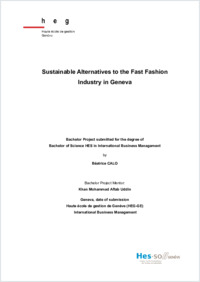Sustainable alternatives to the fast fashion industry in Geneva
SONAR|HES-SO
- Calo, Béatrice
- Khan, Aftab (Degree supervisor)
- Genève : Haute école de gestion de Genève
91 p.
Bachelor of Science HES in International Business Management: Haute école de gestion de Genève, 2021
English
The fast fashion industry is the second most polluting industry in the world, accounting for 10% of global pollution. This industry produces over 92 million tonnes of waste per year and uses 1.5 trillion tonnes of water. Due to the high consumption of water, the garment industry is responsible for ~20% of industrial water pollution, due to the chemicals used in the dyeing and textile treatment which contributes around 35% of oceanic microplastic pollution (Kirsi Niinimäki, 2020). In 2013, an important event highlighted another issue of the fast fashion industry. The negative treatment of workers. In Bangladesh, the Rana Plaza, a building used to manufacture clothes, collapsed in 2013, killing 1132 people. Since this tragic event, working conditions toward the clothes manufacturing industry are being discussed. The main issues are: low salaries, high rate of accidents, contact with chemicals and long working hours (International Labour Organization (ILO). In this context, sustainable alternatives to this industry like ethical shops and secondhand shops are rising. In fact, the ethical market was valued at almost 6.3 billion dollars in 2019 (Michelle Jones, 2021). Despite the growing awareness around the fast fashion industry, it is expected to grow by 60% by 2030 (Edouard Perrin, ARTE, 2020). One of the factors explaining this growth is consumption. Indeed, fast fashion brands manage to create a feeling of emergency and immediate pleasure and by consequence consumption increased (Edouard Perrin, ARTE, 2020). This study aims to identify the sustainable alternatives to reduce the environmental and social negative impacts of the fast fashion industry form the supply and demand side in Geneva. More precisely, the study will look into the existing solutions that the market has to reduce negative externalities. To provide this information, current thinking about the subject has been summarized in the literature review. Moreover, a quantitative analysis has been done via an online survey to question consumers and to understand how the demand side of this market can reduce the negative impact of this industry. Additionally, interviews with experts and shops have been conducted to examine how the fast fashion industry works and what can be implemented to reduce environmental and social negative impact.
- Language
-
- English
- Classification
- Economics
- Notes
-
- Haute école de gestion Genève
- International Business Management
- hesso:hegge
- Persistent URL
- https://sonar.ch/global/documents/319668
Statistics
Document views: 610
File downloads:
- BT_BéatriceCALO_2021_VF.pdf: 586
